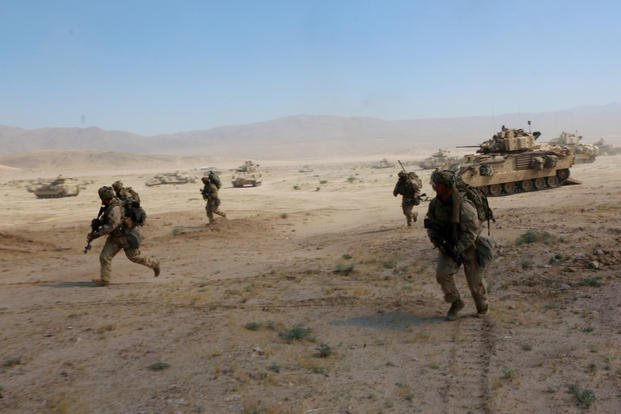Editor’s Note: This is the first of a series of dispatches from the National Training Center at Fort Irwin, California. Reporter Matthew Cox spent May 6-10 embedded with troops there.
FORT IRWIN, California -- After a long night of waiting, Bradley Fighting Vehicles from the 3rd Infantry Division's 2nd Armored Brigade Combat Team, or ABCT, surge through a breached obstacle to attack enemy forces in the fictional town of Razish.
It's midmorning on May 8. Infantrymen wearing bulky chemical protective suits and carrying rucksacks, weapons and ammunition dismount and sprint toward the closest buildings on the outskirts of one of the National Training Center's largest urban complexes.
Enemy rifle and machine-gun fire echoes through the air. M1 tanks and Bradleys from the 2nd ABCT begin to take direct hits from opposing force armor and anti-tank weapons.
"Let's go, let's go! Get inside, get inside!" infantry leaders shout.
"Hey! Hey! We got a dude in the window up there!" another soldier shouts.
In the confusion, small-unit leaders begin to push stacks of infantrymen deeper into the town.
"We got to move straight across [the street]. What we'll do is bound and lay down covering fire for each other!" a leader shouts.
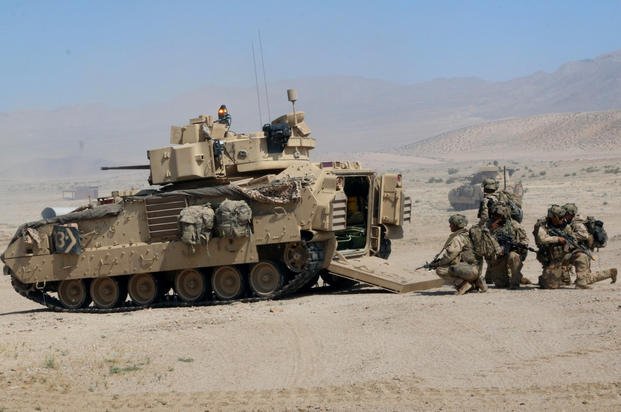
The soldiers and leaders from 2nd ABCT, which was recently converted into an armored unit, are in the middle of a roughly three-week, decisive-action rotation at NTC, a critical part of the Army's strategy to make combat units ready to face near-peer adversaries such as Russia and China in a major war. This year, Army leaders stressed that the combat training center rotations are more important than ever to restoring the service's combat readiness.
For the past five days, commanders, planners, tankers, infantrymen and other soldiers have had to cope with a seasoned enemy force on an ever-changing battlefield that repeatedly alters plans, challenges communications and makes sleep almost impossible.
NTC is designed be a "leadership crucible" that forces units to anticipate enemy ground, air, cyber and electromagnetic attacks.
"It is a very daunting battle rhythm, with multiple threats at all times that the brigade has to deal with across the spectrum. So there is not just one threat; they are fighting all forms of contact," said Col. Carl Michaud, deputy commander of NTC.
Changing Plans on the Fly
Elements from 2nd ABCT captured the town of Razish by noon, but the attack unfolded far differently than the original plan.
"It was chaotic. A little ugly, but we had more success than we thought we would," Capt. Eric Cannon, commander of Charlie Company, 2ndBattalion, 69th Armor Regiment, told Military.com.
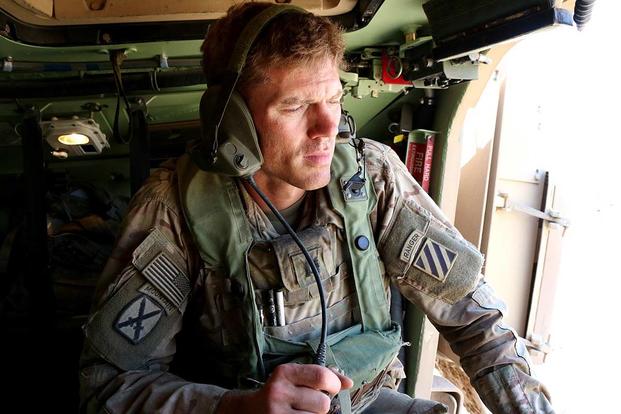
Cannon's mechanized infantry company, which is equipped with 15 Bradleys, was supposed to follow Charlie Company, 3rd Battalion, 67th Armor Regiment, and Alpha Company, 3rd Battalion, 15th Infantry Regiment, through the breach point, and move deeper into town after 3-67 and 3-15 gained an initial foothold.
"But the fear was [enemy forces] were going to reseal the breach lane, create more obstacles and have more counter-attack forces, so we wanted to get as much combat power in there as possible," Cannon said.
"So, when we got to the breach, you had three companies that were all intermixed, and it was chaos. ... You had vehicles pulling up, dropping off guys, pulling back, vehicles getting destroyed," he said. "There was no real control over it. Comms were full, too much talking. I couldn't get on the net and really communicate with anyone effectively, and a lot of my commander buddies couldn't either."
In the end, leaders scrapped the initial plan and kept it simple, Cannon said.
"So, what you saw was a lot of guys going around and grabbing guys and putting them where they needed to be," Cannon said. "Units got intermixed, but we just figured out, if you were wearing the same uniform, we just tried to orient guys on the same plan of attack. ... You saw company commanders out here pushing guys forward, and platoon sergeants doing the same thing."
NTC and Army Readiness
NTC is one of the Army's three combat training centers (CTCs) that began to transition from mission-rehearsal exercises for Iraq and Afghanistan to decisive-action rotations in 2011.
This year, Army leaders requested funding in its fiscal 2020 budget request to pay for 25 CTC rotations compared to the 20 it requested in fiscal 2019 -- a move designed to meet the requirements of the 2018 National Defense Strategy which identifies Russia and China as the top potential adversaries of the United States.
NTC's sprawling training areas in the Mojave Desert plays a key role in the service's plan to achieve its readiness goals by 2022.
"We don't duplicate any part of the world. We use a scenario builder called DATE -- Decisive Action Training Environment," Michaud said. "We do that to incorporate all the threats out there that we could possibly face, and then we try to amalgamate it into one scenario."
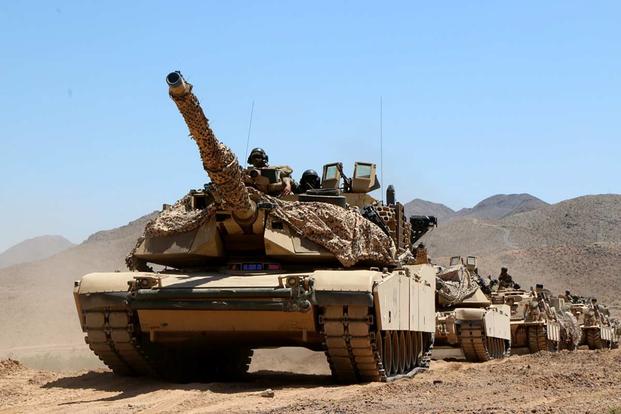
Set in the fictitious country of Atropia, Army BCTs are forced to defend U.S. allies against an aggressor to the north known as Donovia on a battlefield the size of Rhode Island.
"We are unique in the fact that we are very large -- 1,000 square miles and getting bigger," Michaud said, adding that NTC owns the airspace up to 29,000 feet.
The massive training center also "owns the spectrum," so it can jam a BCT's tactical radio network and disrupt its GPS systems, he said.
"We can induce those events that they could expect to see in the modern battlefield," Michaud said.
"Black Horse" units of the 11th Armored Cavalry Regiment make up the opposing force, or OPFOR, at NTC.
The armored force is equipped with nearly 200 hybrid vehicles, including M113s equipped with Bradley turrets to replicate Russian Army BMP 3 fighting vehicles and T90 tanks, Michaud said. OPFOR units are also equipped with reconnaissance drones, as well as UH-72 Lakota helicopters painted in desert camouflage.
Taking Casualties
During the attack on Razish, 2nd ABCT units were able to surge deep into the town, but suffered heavy casualties as a result.
"We lost all of our Bradleys at some point," Cannon said. "Initially, there were a lot of [anti-tank guided missiles] in the breach; then they brought mortars and BMPs and some other armored vehicles.
"We just didn't do a good job identifying those threats prior to ... going into the breach," he added.
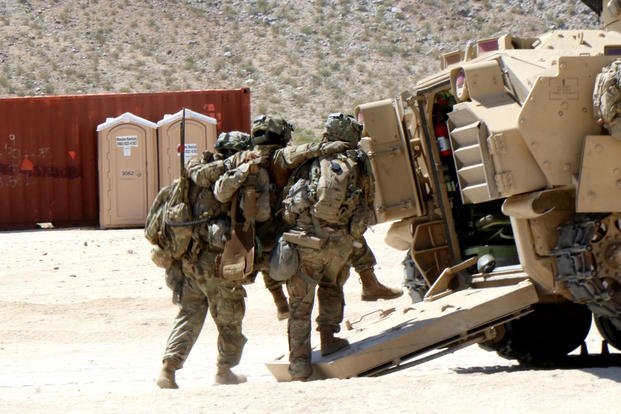
Pvt. Isaac Lemos, a 20-year-old infantryman with Alpha Company, 3-15, said he was killed during the attack on Razish when enemy fire caused his Multiple Integrated Laser Engagement System (MILES) to go off.
"Our guys started getting killed off as we were flowing through the buildings," Lemos said. "We noticed we were taking more contact to the far side and, once I came into this building, I noticed I had been shot. ... My MILES went off."
Lemos said his first experience with NTC is "definitely bigger" than any training he has seen so far in the Army.
"I feel like everybody gets a little more training in it because, when our leadership gets killed off, the privates have to step in and we show them what we are made of," he said.
For Cannon, this is a new experience on many levels. He has spent most of his eight years in the Army in light infantry units, deploying two times to Afghanistan with the 10th Mountain Division. He then joined the Spartan brigade as it converted to an ABCT just over a year ago, he said.
"This is not only a new formation -- a different type of formation -- it's a different type of fight, so essentially the challenge is going back into doctrine and relearning everything we were taught long ago and learning how to apply it in a real-life scenario that's modern," said Cannon, who added that this is his first time at NTC.
"We have [enemy] drones flying over the battlefield; we have enemy with helicopters and weapons that can outrange us. It's a dynamic battlefield, so there are a lot of plans that are immediately changed, and a lot of different variables that are thrown at you, so you have to be adaptive," he said.

Lt. Col. Arthur McGrue III, commander of 3-15, has been to NTC on two other occasions, so the training center's unique challenges are not new to him.
"This place is designed to defeat us," said McGrue, sitting in his battalion tactical operations center at 10:30 p.m. May 9. "With the Razish mission, we took a lot of casualties. I think, across the board, my battalion was down to, like, two Bradleys."
McGrue and other 2nd ABCT leaders would not give specific casualty numbers for operational security reasons.
"For me, the thing that went right was our ability to show violence of action in getting through the breach," he said. "We coordinated with the unit that was in front of us so that, when they were successful with the breach, we would be right behind them to go through the breach lane."
One of the major differences between NTC and home-station training is the cadre of observer-controllers who mentor the unit as it negotiates the challenges of the training center.
"They are absolutely learning on the job," said Maj. James Carr, brigade executive officer trainer at NTC. "Given where we are, we see the brigade certainly improving and evolving in their ability to plan and execute operations.
"Are we at the finished, refined, complete product? No. But we are certainly on the road to getting much better," he added.
On the Razish attack, Carr said that 2nd ABCT units "did not do badly."
"They did alright. Some of it might have fell out of sequence and could have been improved, but they pretty much did alright, so kudos to them," he said. "They are a newly formed armored brigade combat team, so they have had a steep learning trajectory to get to where they are and, considering that they have only had [several] months or so to get to where they are, they are doing pretty well."
Col. Patrick O'Neal, commander of 2nd ABCT, is on his fourth rotation at NTC, but it's still a new experience, he said.
"The first time, I went as a second lieutenant. Now I am a colonel. Every time you go, you are in a different job -- you are familiar with the environment, you are familiar with the enemy, but your role is different," he said. "The best analogy I can give you is, it sort of shines a bright flashlight deep inside your organization, and it lets you see everything that you are good at and everything that you are not good at. ... So out of this, you become a better soldier, a better leader and, by direct result of that, a better unit."
-- Matthew Cox can be reached at matthew.cox@military.com.
